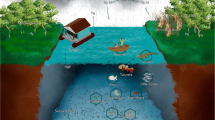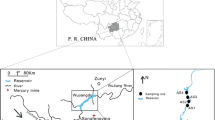Abstract
Three Oregon reservoirs were evaluated for environmental parameters affecting mercury (Hg) dynamics and bioaccumulation in fish using an ecoregion approach. Ecoregions are distinguished by topography, geology, soil type and composition, and land use patterns. We examined: pH, dissolved oxygen, hardness, conductivity and concentration of Hg ([Hg]) in water; and complexing agent concentrations, organic content, inorganic and organic [Hg] in sediments; and [Hg] in three fish species. [Hg] in water was below detection (0.1 μg/L) in most water samples from the three reservoirs; in samples above detection, we reasoned that Hg was predominantly in the particulate fraction. Hg in sediment was only found consistently in the inorganic state; organic mercury was below detection (0.2 ng/g) in 83% of sediment samples. Muscle [Hg] in fish over 4 years old was above the FDA limit of 1.0 μg/g wet weight, and more than 90% of the Hg in all fish was organic mercury. [Hg] in lateral muscle was similar between smallmouth bass (Micropterus dolomieu) in Owyhee Reservoir and largemouth bass (Micropterus salmoides) in Cottage Grove Reservoir; rainbow trout (Salmo gairdneri) from Ochoco Reservoir had significantly lower levels of Hg. It is concluded that, although ecoregion parameters alone do not explain mercury dynamics, they may influence the methylation rate in areas of similar Hg loading rates.
Similar content being viewed by others
References
Akielaszek JJ, Haines TA (1981) Mercury in the muscle tissue of fish from three northern Maine lakes. Bull Environ Contam Toxicol 27:201–208
Allard M, Stokes PM (1989) Mercury in crayfish species from thirteen Ontario lakes in relation to water chemistry and smallmouth bass (Micropterus dolomieui) mercury. Can J Fish Aquat Sci 46:1040–1046
American Public Health Association, American Water Works Association, and Water Pollution Control Federation (1985) Greenberg AE, Trussell RR, Clesceri LS (eds) Standard methods for the examination of water and wastewater, 16th ed. American Public Health, Washington, DC
Baldwin EM (1976) Geology of Oregon, Edwards Brothers, Ann Arbor, MI
Beijer K, Jernelov A (1979) Methylation of mercury in aquatic environments. Elsevier Press, Amsterdam, p 203
Bodaly, RA, Hecky RE, Fudge RJP (1984) Increases in fish mercury levels in lakes flooded by the Churchill River Diversion, Northern Manitoba. Can J Fish Aquat Sci 41:682–691
Brooks H (1971) Quicksilver deposits in Oregon. Department of Geology and Mineral Industries, Portland, OR, miscellaneous paper #15
Buhler D, Reed R, Caldwell R (1984) As assessment of projected mercury levels in the proposed Galloway Dam project on the Weisser River, Idaho. Report submitted to the US Army Corps of Engineers
Eisler R (1987) Mercury hazards to fish, wildlife, and invertebrates: A synoptic review. US Fish Wildl Serv Biol Rep 85(1.10), Washington, D.C., 90 pp
Furutani A, Rudd JWM (1980) Measurement of mercury methylation in lake water and sediment samples. Appl Environ Microbiol 40:770–776
Gallant A, Whittier T, Larsen D, Omernik J, Hughes R (1989) Regionalization as a tool for managing environmental resources. EPA/600/3–89–060, US Environmental Protection Agency, Washington, DC
Giovanoli-Jakubczak T, Grrenwood MR, Crispin J, Clarkson TW (1974) Determination of total and inorganic mercury in hair by flameless atomic absorption, and methylmercury by gas chromatography. Clin Chem 20:222–229
Grieb TM, Driscoll CT, Gloss SP, Schofield CL, Bowie GL, Porcella DB (1990) Factors affecting mercury accumulation in fish in the Upper Michigan Peninsula. Environ Toxicol Chem 9:919–930
Håkanson L, Andersson T, Nilsson A (1990) Mercury in fish in Swedish lakes—linkages to domestic and European sources of emission. Water Air Soil Pollut 50:171–191
Håkanson L (1980) The quantitative impact of pH, bioproduction and Hg-contamination on the Hg-content of fish (pike). Environ Pollut 1B:285–304
Hill S (1973) Study of mercury and heavy metals pollutants in the Jordan Creek Drainage. Unpublished report, College of Mines, University of Idaho, Moscow, ID
Huckabee JW, Elwood JW, Hildebrand SG (1979) Accumulation of mercury in freshwater biota. In: Nriagu JO (ed) The biogeochemistry of mercury in the environment. Elsevier Amsterdam, p 277
Jackson TA (1991) Biological and environmental control of mercury accumulation by fish in lakes and reservoirs of Northern Manitoba, Canada. Can J Fish Aquat Sci 48:2449–2470
Jackson TA, Woychuk RN (1980) The geochemistry and distribution of mercury in the Wabigoon river system. In: Jackson TA (ed) Mercury pollution in the Wabigoon-English river system of northeastern Ontario, and possible remedial measures: a progress report, Ontario Ministry of the Environment, Toronto, Ontario, pp 1–28
Jearld, A Jr (1983) Age determination. In: Nielson LA, Johnson DL, Lampton SS (eds) Fisheries techniques. Am Fish Soc, Bethesda, MD, p 301
Jenne EA (1973) Mercury in waters of the western U.S. In: Buhler DR (ed) (ed) Mercury in the western environment. Oregon State University, Corvallis, OR, pp 16–28
Jernelov A, Asell B (1973) The feasibility of restoring mercury-contaminated waters. In: Krenkel PA (ed) Heavy metals in the aquatic environment: an international conference. Pergammon Press, NY, pp 299–309
Johnson DM, Petersen RR, Lycan DR, Sweet JW, Neuhaus ME (1985) Atlas of Oregon lakes. Oregon State University Press, Corvallis, OR
Johnston TA, Bodaly RA Mathias JA (1991) Predicting fish mercury levels from physical characteristics of boreal reservoirs. Can J Fish Aquat Sci 48:1468–1475
Klein DH (1973) Sources and present status of the mercury problem. In: Buhler DR (ed) Mercury in the western environment. Oregon State University Press, Corvallis, OR, pp 1–13
Lacerda LD, Pfeiffer WC, Marins RV, Rodrigues S, Souza CMM, Bastos WR (1991) Mercury dispersal in water, sediemtns, and aquatic biota of a gold mining tailing deposit drainage in Pocone, Brazil. Water Air Soil Pollut 55:283–294
Lindberg S, Stokes PM, Goldberg E, Wren C (1987) Group report: Mercury. In: Hutchinson TC, Meema KM (eds) Lead, cadmium, mercury and arsenic in the environment. John Wiley & Sons, NY, pp 17–33
Lowe TP, May TW, Brumbaugh WG, Kane DA (1985) National contaminant biomonitoring program: Concentrations of seven elements in freshwater fish, 1978–1981. Arch Environ Contam Toxicol 14:363–388
Magos L, Clarkson TW (1972) Atomic absorption determination of total, inorganic, and organic mercury in blood. JAOAC 55:966–971
McMurty MJ, Wales DL, Scheider WA, Beggs GL, Dimond PE (1989) Relationship of mercury concentrations in lake trout (Salvelinus namaycush) and smallmouth bass (Micropterus dolomieui) to the physical and chemical characteristics of Ontario lakes. Can J Fish Aquat Sci 46:426–434
Nriagu JO (1979) Production and uses of mercury. In: Nriagu JO (ed) The biogeochemistry of mercury in the environment, Elsevier Amsterdam, pp 23–40
Omernik J, Gallant A (1986) Ecoregions of the Pacific Northwest. EPA/600/3–86–033, US Environmental Protection Agency, Washington, DC
Oregon Department of Geology and Mineral Industries (1982) Geothermal resources of Oregon (map), Portland, OR
Phillips GR, Medvick PA, Skaar DR, Knight D (1987) Factors affecting the mobilization, transport, and bioavailability of mercury in reservoirs of the Upper Missouri River Basin. Tech Rep #10. U.S. Department of the Interior, Fisheries and Wildlife Service, Washington, DC
Phillips GR (1975) Some quantitative aspects of mercury accumulation by rainbow trout. PhD dissertation, Oregon State University, Corvallis, OR
Rada RG, Wiener JG, Winfrey MR, Powell DE (1989) Recent increases in atmospheric deposition of mercury to North-Central Wisconsin lakes inferred from sediment analyses. Arch Environ Contam Toxicol 18:175–181
Ramlal PS, Rudd JWM, Hecky RE (1986) Methods for measuring specific rates of mercury methylation and degradation and their use in determining factors controlling net rates of mercury methylation. Appl Environ Microbiol 51:110–114
Richman LA, Wren CD, Stokes PM (1988) Facts and fallacies concerning mercury uptake by fish in acid stressed lakes. Water Air Soil Pollut 37:465–473
Schindler DW, Hesslein RH, Wagemann R, Broecker WS (1980) Effects of acidification on mobilization of heavy metals and radionuclides from the sediments of a freshwater lake. Can J Fish Aquat Sci 37:1723–1729
Scott WB, Crossman EJ (1973) Freshwater fishes of Canada. Fish Res Board Can Bull 184, Ottawa, Ontario, 966 pp
Sorensen, JA, Glass GE, Schmidt KW, Huber JK, Rapp GR Jr (1990) Airborne mercury deposition and watershed characteristics in relation to mercury concentrations in water, sediments, plankton, and fish of eighty Northern Minnesota lakes. Environ Sci Technol 24:1716–1727
Stokes PM, Wren CD (1987) Bioaccumulation of mercury by aquatic biota in hydroelectric reservoirs: a review and consideration of mechanisms. In: Hutchinson TC, Meema KM (eds) Lead, cadmium, mercury and arsenic in the environment. John Wiley & Sons, NY, pp 255–277
Suns K, Hitchin G (1990) Interrelationships between mercury levels in yearling yellow perch, fish condition, and water quality. Water Air Soil Pollut 50:255–265
Uthe JF, Solomon J, Grift B (1972) Rapid semi-micro method for the determination of methyl mercury in fish tissue. JAOAC 55(3):583–589
Weiner JG, Fitzgerald WF, Watras CJ, Rada RG (1990a) Partitioning and bioavailability of mercury in an experimentally acidifed Wisconsin lake. Arch Environ Contam Toxicol 9:909–918
Wiener JG, Martini RE, Sheffy TB, Glass GE (1990b) Factors influencing mercury concentrations in walleyes in Northern Wisconsin Lakes. Trans Am Fish Soc 119:862–870
Wiklander L (1969) The content of mercury in Swedish groundwater and river water. Geoderma 3:75–79
Winfrey MR, Rudd JWM (1990) Environmental factors affecting the formation of methylmercury in low pH lakes. Environ Toxicol Chem 9:853–869
Worcester TC (1979) Mercury accumulation in fish from Cottage Grove Reservoir and its tributaries. MS thesis, Oregon State University, Corvallis, OR
Wren CD, Scheider WA, Wales DL, Muncaster BW, Gray IM (1991) Relation between mercury concentrations in walleye (Stizostedion vitreum vitreum) and northern pike (Esox lucius) in Ontario lakes and influence of environmental factors. Can J Fish Aquat Sci 48:132–139
Author information
Authors and Affiliations
Rights and permissions
About this article
Cite this article
Allen-Gil, S.M., Gilroy, D.J. & Curtis, L.R. An ecoregion approach to mercury bioaccumulation by fish in reservoirs. Arch. Environ. Contam. Toxicol. 28, 61–68 (1995). https://doi.org/10.1007/BF00213970
Issue Date:
DOI: https://doi.org/10.1007/BF00213970




